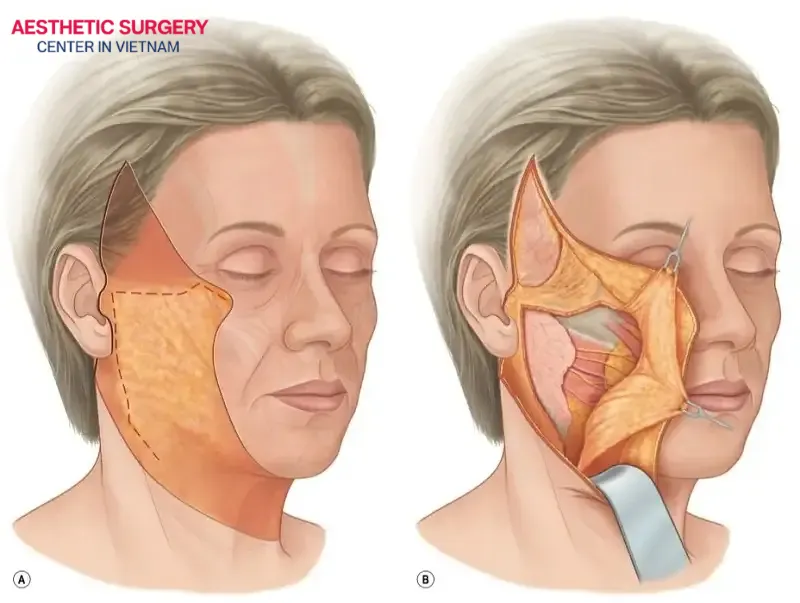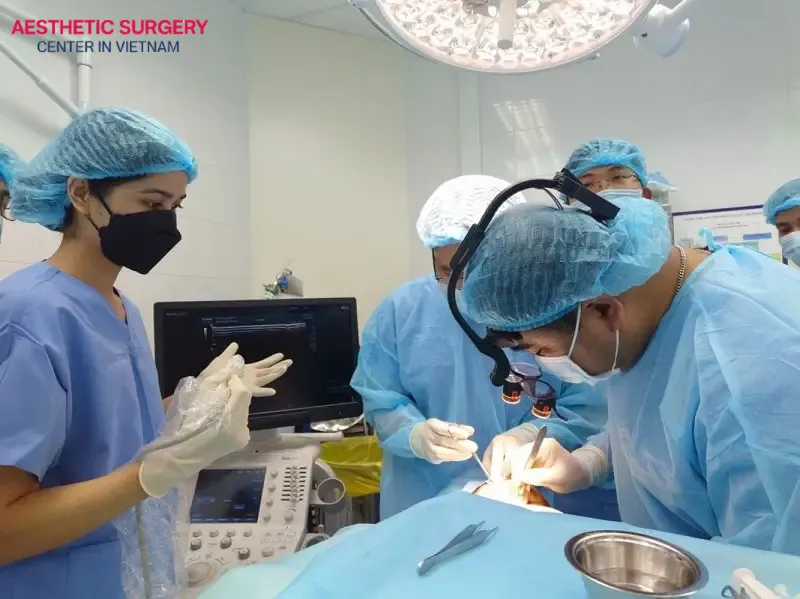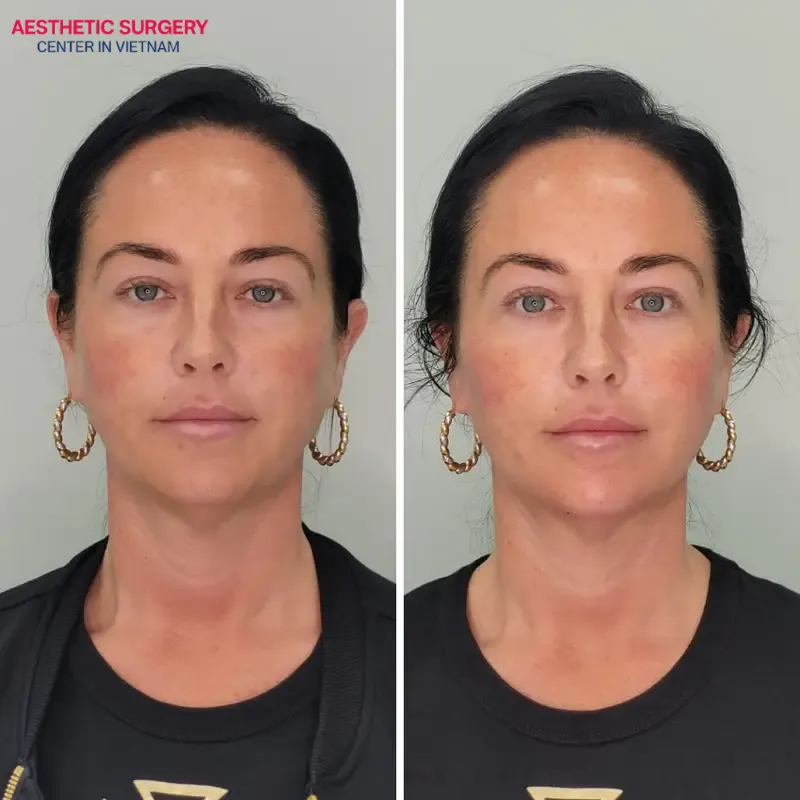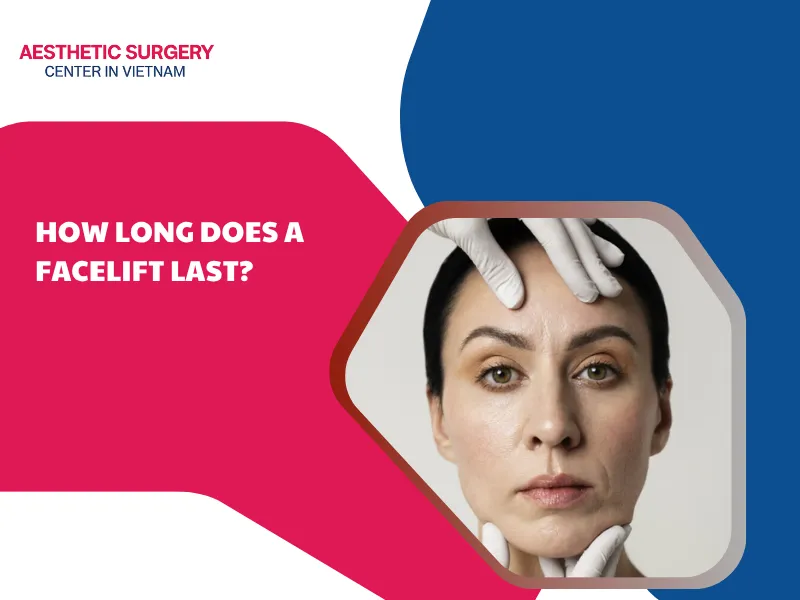A facelift is a cosmetic procedure that provides comprehensive and long-lasting facial rejuvenation by improving sagging and wrinkled skin through the removal of excess skin and the restructuring of underlying muscles, particularly the SMAS (superficial musculoaponeurotic system). However, when considering this facial rejuvenation solution, the question most people ask is: how long does a facelift last? To find the answer, refer to this article with Facelift Tips for detailed and accurate information.
How long does a facelift last?
How long does a facelift last? A facelift is a cosmetic procedure that uses surgical techniques or advanced devices to dissect tissues, tighten sagging skin, and lift lax muscles in the face and neck. During the procedure, the surgeon removes excess, loose skin and then sutures the area to eliminate wrinkles, tighten the skin, and restore a youthful, smooth appearance. This procedure can be performed as a full facelift or a partial facelift, depending on the degree of aging and skin laxity in each patient.

Facelift surgery can maintain rejuvenation results for approximately 10 to 15 years if it involves deep intervention into the facial muscle system and is performed with precise technique combined with proper postoperative care. If the surgery only affects the superficial skin, the results usually last a shorter period, around 1 to 2 years. Therefore, the longevity of a facelift also depends on the surgical technique, individual patient characteristics, and postoperative care.
Overall, this procedure provides long-lasting aesthetic results and effectively addresses visible signs of skin aging.

See more: Facelift recovery process
Factors that affect the longevity of a facelift
The reason the longevity of facelift results varies from person to person is that it is influenced by several factors, including:
- Facelift methods: Each facelift technique offers different outcomes, levels of rejuvenation, and durations of effectiveness. For instance, traditional facelift surgery tends to provide more durable and long-lasting results compared to mini facelift procedures or liquid facelift techniques.
- Skin condition & age: Healthy skin with good elasticity and minimal sagging will maintain facelift results longer compared to severely aged or highly lax skin. In addition, age is an important factor affecting the longevity of facelift outcomes, with procedures performed at a younger age generally providing longer-lasting results than those done in older individuals.
- Lifestyle habits: After surgery, individuals who follow proper care, protecting the skin from sun exposure, avoiding trauma to the surgical area, maintaining a healthy lifestyle, using appropriate skincare, and ensuring proper nutrition, can prolong the longevity of facelift results. Conversely, neglecting skincare, poor nutrition, and the use of stimulants can shorten the duration of the results.
- Surgeon’s skill and experience: This factor greatly influences the longevity of facelift results. A highly skilled surgeon with precise technique can correctly position the tissue, tighten the muscles appropriately, and minimize the risk of tissue damage, resulting in longer-lasting outcomes and a more natural facial appearance.

Signs that your facelift needs a touch-up
Although facelift surgery provides long-lasting aesthetic results, the body’s natural aging process continues over time. This can alter certain facial features, signaling the need for a repeat facelift. Specifically, the most common signs include:
- Sagging skin: Excess, loose skin on the cheeks and jaw; deep wrinkles on the chin and neck, such as pronounced smile lines and marionette lines; and severely lost skin elasticity. If lifting this area would restore a more youthful appearance, these are signs that a repeat facelift may be needed.
- Deeper wrinkles: If some time after a facelift you notice deeper wrinkles or folds appearing on the face, especially around the mouth and nose, these are signs that a repeat facelift may be necessary.
- Loss of facial volume: A facelift helps redefine facial contours, making the face appear fuller and smoother. However, as we age, facial volume gradually decreases, reducing the procedure’s effectiveness. The chin, jaw, and neck may become lax, causing the face to lose its previous slimness and definition. This is a sign that a repeat facelift may be needed.
- Changes in facial structure: The body’s natural aging process alters facial structure, causing previously defined features to lose their clarity. This is a sign that a repeat facelift may be necessary.

When you notice signs of sagging, deep wrinkles, loss of facial definition, or decreased facial volume, you should consider a repeat facelift. However, to ensure safety and effectiveness in rejuvenating your face again, it is essential to visit a reputable clinic where a specialist can assess the need for revision surgery and choose the most appropriate technique.
How many times can you get a facelift?
You can undergo facelift surgery multiple times; however, the number of safe and effective procedures depends on your overall health and the surgeon’s expertise. Typically, after the first facelift, if signs of sagging or aging appear again after several years, a second procedure can be performed to remove excess skin and lift lax muscles.
However, a second facelift requires careful consideration because after the first surgery, the hairline and areas around the ears may have slight changes, and if the procedure is not performed carefully, it could affect the facial nerves. Additionally, undergoing multiple facelifts should be based on cardiovascular health assessments, overall physical condition, and a professional evaluation by the surgeon before proceeding.

What specific steps are recommended for facelift patients?
To maintain long-lasting facelift results, you need to follow a healthy lifestyle, take proper care of your skin, and adhere to the following guidelines:
- Always follow postoperative instructions carefully, adhere to the surgeon’s aftercare guidance, attend all scheduled follow-up appointments, and take prescribed medications fully to manage pain, reduce inflammation and swelling, and prevent infection.
- During the first 2–5 days after surgery, apply cold compresses to the face 4–6 times a day for 15–20 minutes each time to reduce swelling, bruising, and mild pain from tissue trauma. Be sure not to place ice directly on the skin; always wrap it in a soft cloth before applying.
- Wear a wide-brimmed hat when going outdoors and apply a high-SPF sunscreen daily to protect the healing skin. Additionally, avoid exposure during peak UV hours.
- Eat soft, easily digestible foods for the first 5–7 days, and avoid foods that may cause allergies or keloid formation, such as chicken, seafood, and water spinach.
- Drink plenty of water to keep your body and skin hydrated, helping maintain long-lasting results. Additionally, use moisturizer regularly to keep your skin smooth and supple.
- Limit vigorous movements of the face and head to avoid increasing pressure on the surgical area, which helps reduce the risk of bruising and prolonged swelling.
- If you experience severe pain, significant swelling, bleeding, or pus at the incision site, contact your surgeon immediately for prompt management.
- Avoid stimulants such as alcohol, beer, and tobacco, as they can slow wound healing and negatively affect aesthetic results.
- In addition to proper care and maintaining a healthy lifestyle, you can also consider non-surgical skin rejuvenation methods such as laser treatments, chemical peels, filler injections, and Botox to help maintain a radiant appearance.

Overall, careful and proper postoperative care is a key factor in ensuring that facelift results are long-lasting and safe for the skin.
See more: How much does a facelift cost in Viet Nam?
From the information Aesthetics Surgery Center shared about how long a facelift lasts, it is clear that facelift results can be quite long-lasting. However, this depends on various factors. To achieve durable facelift results, it is important to choose a reputable clinic, the appropriate facelift technique, and a highly skilled surgeon, as well as to maintain proper postoperative care and a healthy lifestyle. Additionally, when signs of aging reappear, a repeat facelift at a trusted facility may be necessary.




















Comment on the post